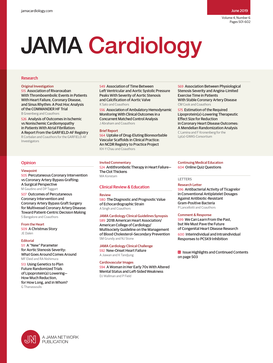Transthyretin Cardiac Amyloidosis in Older Black and Hispanic Individuals With Heart Failure.
IF 14.1
1区 医学
Q1 CARDIAC & CARDIOVASCULAR SYSTEMS
引用次数: 0
Abstract
Importance Transthyretin cardiac amyloidosis (ATTR-CA) is an underdiagnosed but treatable cause of heart failure (HF) in older individuals that occurs in the context of normal wild-type (ATTRwt-CA) or an abnormal inherited (ATTRv-CA) TTR gene variant. While the most common inherited TTR variant, V142I, occurs in 3% to 4% of self-identified Black Americans and is associated with excess morbidity and mortality, the prevalence of ATTR-CA in this at-risk population is unknown. Objective To define the prevalence of ATTR-CA and proportions attributable to ATTRwt-CA or ATTRv-CA among older Black and Caribbean Hispanic individuals with HF. Design, Setting, and Participants This prospective, multicenter, cross-sectional study was conducted in several major US cities (Boston, Massachusetts; New York, New York; and New Haven, Connecticut) among individuals who self-identified as Black or Caribbean Hispanic older than 60 years with HF. Participants were enrolled between May 2019 and June 2024, and data analysis was conducted from June 2024 to May 2025. Main Outcomes and Measures ATTR-CA was determined by radionuclide imaging, with blood testing to exclude light-chain amyloidosis and genotyping to determine TTR gene variant. Echocardiographic, biochemical, physical performance, and quality-of-life data were collected. Results Among 646 participants, median (IQR) participant age was 73 (66-80) years, 329 (50.6%) were women, 550 (85.1%) identified as Black, and 186 (28.8%) identified as Caribbean Hispanic. Median (IQR) left ventricular wall thickness was 13 (12-14) mm, and median (IQR) left ventricular ejection fraction was 61% (55%-66%). Overall prevalence of ATTR-CA was 6.66% (95% CI, 4.73%-8.58%), of whom 24 (55.8%) had ATTRwt-CA and 19 (44.2%) had ATTRv-CA owing to V142I. Overall prevalence of V142I allele was 5.6%, and of those, 19 (52.8%) had ATTRv-CA. Prevalence of ATTR-CA was 8.15% (95% CI, 5.15%-11.15%) in men and 5.20% (95% CI, 2.79%-7.61%) in women (P = .13). Prevalence of ATTR-CA was 7.82% (95% CI, 5.57%-10.06%) in Black participants and 2.15% (95% CI, 0.07%-4.24%) in Hispanic participants (P = .004). Among Black participants aged 75 years or younger, ATTR-CA was observed in 3.42% of participants (95% CI, 1.43%-5.40%) compared to 14.04% (95% CI, 9.53%-18.54%) of those older than 75 years (P < .001). Among Black male participants older than 75 years, prevalence of ATTR-CA was 17.17% (95% CI, 9.74%-24.60%). Conclusions and Relevance In this cross-sectional study, ATTR-CA was an important cause of HF in older Black individuals with HF, particularly in men older than 75 years. Approximately half of V142I carriers with HF had ATTR-CA, while 55.8% of all ATTR-CA cases had normal TTR genotype. Trial Registration ClinicalTrials.gov Identifier: NCT03812172.老年黑人和西班牙裔心力衰竭患者的转甲状腺素型心脏淀粉样变性。
转甲状腺素型心脏淀粉样变性(atr - ca)是老年人心衰(HF)的一种未被诊断但可治疗的原因,发生在正常野生型(attrt - ca)或异常遗传(ATTRv-CA) TTR基因变异的背景下。虽然最常见的遗传性TTR变异V142I发生在3%至4%的自我认定的美国黑人中,并与过高的发病率和死亡率有关,但在这一高危人群中,atr - ca的患病率尚不清楚。目的确定老年黑人和加勒比海西班牙裔心衰患者中attri - ca的患病率和归因于attri - ca或attri - ca的比例。设计、环境和参与者本前瞻性、多中心、横断面研究在美国几个主要城市(马萨诸塞州的波士顿、纽约州的纽约和康涅狄格州的纽黑文)进行,研究对象为60岁以上的黑人或加勒比海西班牙裔心衰患者。参与者于2019年5月至2024年6月入组,数据分析于2024年6月至2025年5月进行。主要结果和测量方法通过放射性核素显像检测TTR- ca,血液检测排除轻链淀粉样变,基因分型确定TTR基因变异。收集超声心动图、生化、生理表现和生活质量数据。结果在646名参与者中,中位年龄(IQR)为73岁(66-80岁),329名(50.6%)为女性,550名(85.1%)为黑人,186名(28.8%)为加勒比西班牙裔。中位(IQR)左室壁厚13 (12-14)mm,中位(IQR)左室射血分数61%(55%-66%)。atr - ca总患病率为6.66% (95% CI, 4.73% ~ 8.58%),其中24例(55.8%)为atr - ca, 19例(44.2%)为V142I所致。V142I等位基因总体患病率为5.6%,其中有19例(52.8%)发生ATTRv-CA。atr - ca的患病率男性为8.15% (95% CI, 5.15%-11.15%),女性为5.20% (95% CI, 2.79%-7.61%) (P = 0.13)。黑人受试者的atr - ca患病率为7.82% (95% CI, 5.57%-10.06%),西班牙裔受试者的患病率为2.15% (95% CI, 0.07%-4.24%) (P = 0.004)。在75岁或以下的黑人参与者中,3.42%的参与者(95% CI, 1.43%-5.40%)观察到atr - ca,而75岁以上的参与者中有14.04% (95% CI, 9.53%-18.54%) (P < .001)。在75岁以上的黑人男性参与者中,atr - ca的患病率为17.17% (95% CI, 9.74%-24.60%)。结论和相关性在这项横断面研究中,atr - ca是老年黑人HF患者(尤其是75岁以上男性)发生HF的重要原因。大约一半的HF V142I携带者患有atr - ca,而所有atr - ca病例中有55.8%为正常的TTR基因型。临床试验注册号:NCT03812172。
本文章由计算机程序翻译,如有差异,请以英文原文为准。
求助全文
约1分钟内获得全文
求助全文
来源期刊

JAMA cardiology
Medicine-Cardiology and Cardiovascular Medicine
CiteScore
45.80
自引率
1.70%
发文量
264
期刊介绍:
JAMA Cardiology, an international peer-reviewed journal, serves as the premier publication for clinical investigators, clinicians, and trainees in cardiovascular medicine worldwide. As a member of the JAMA Network, it aligns with a consortium of peer-reviewed general medical and specialty publications.
Published online weekly, every Wednesday, and in 12 print/online issues annually, JAMA Cardiology attracts over 4.3 million annual article views and downloads. Research articles become freely accessible online 12 months post-publication without any author fees. Moreover, the online version is readily accessible to institutions in developing countries through the World Health Organization's HINARI program.
Positioned at the intersection of clinical investigation, actionable clinical science, and clinical practice, JAMA Cardiology prioritizes traditional and evolving cardiovascular medicine, alongside evidence-based health policy. It places particular emphasis on health equity, especially when grounded in original science, as a top editorial priority.
 求助内容:
求助内容: 应助结果提醒方式:
应助结果提醒方式:


